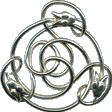Triangles
Some of my earliest memories are of Dad introducing me to Pythagorean triangles and encouraging me to test Pythagoras' theorem for myself by drawing triangles and investigating their properties. He also introduced me to the "Magic Picture Frame", which is a delightful visual proof of Pythagoras theorem. I have no doubt that by encouraging me to be friendly with numbers and to associate numbers and logic with visual representations, my father gave me a wonderful gift that has opened up opportunities for me all my life. All children should have the chance to encounter triangles, even if the more advanced topics are best left until a bit later in life.
My father, Jeffery Lewins, is primarily an engineer and thermodynamicist, but he has always been interested in Pythagorean triangles and in particular Pythagorean triples, that is right-angled triangles where all three sides are of integer length. The best known Pythagorean triple has sides of 3, 4, 5 (in whatever units you choose), and it demonstrates Pythagoras theorem when you calculate that 3^2 + 4^2 = 9 + 16 = 25 = 5^2. But there are many, many more.
How many Pythagoran triples are there? Do they occur randomly or are there patterns to them? These and other musings have led him to write a discourse on Pythagorean triples, which you can read below. Much of the work in this discourse is original in that he deduced it from first principles, however it was previously discovered by other mathematicians so is not generally new to the world. The material presented here tells the story of the Pythagorean triple through one man's eyes.
The Magic Picture Frame
Create a Magic Picture Frame to introduce children to Pythagoras' theorem.
The Magic Picture FrameShelagh's Triangles
A discourse on the Pythagorean triple and its patterns.
Shelagh's TrianglesThe Lewins Conjecture
Extracted and expanded from the Pythagorean discourse above, the Lewins Conjecture relates the difference between the two short sides of a Primitive Pythagorean Triple, to primes and products of primes of a certain modularity. The conjecture is in two parts: the first part is proven: the second has been verified for numbers up to five million by a Perl script written by Alister Perrott in 2014.
The Lewins ConjectureFourier Decomposition
An addendum to Shelagh's Triangles, providing a Fourier decomposition of Pythagorean triples.
Fourier Decomposition